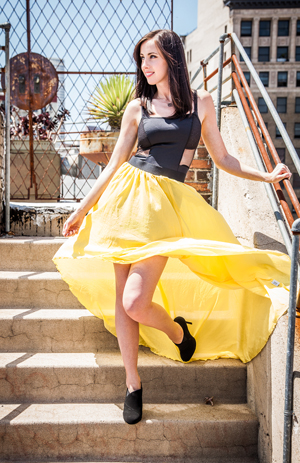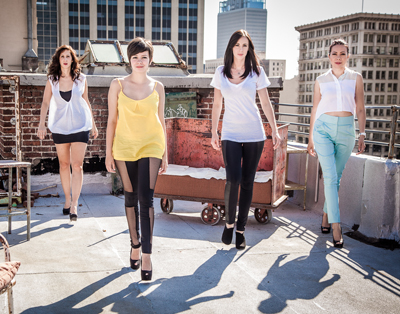 Emerging Designer Jennifer Krischer on how she designs sustainably
Emerging Designer Jennifer Krischer on how she designs sustainably
By Heather Finn
Every year, Phoenix Fashion Week invites a group of young, budding designers to compete in its annual Emerging Designer Contest. It’s not every year, however, that one of those designers is someone who makes conscious efforts to keep her brand green.
This year, Jennifer Krischer of Los Angeles-based brand Linden is that designer.
After the Phoenix Fashion Week team traveled to eight major cities in both the U.S. and Mexico on their search for 12 “Emerging Designers,” Krischer was chosen to participate in the 9th Annual Phoenix Fashion Week’s prestigious competition. In her case, winning the title of Phoenix Fashion Week Emerging Designer 2013 would mean expanding her eco-conscious brand.
SUSTAINABLE FASHION
The most fundamentally green aspect of Linden is Krischer’s use of recycled materials in her designs. She’ll often use deadstock, which is extra fabric that was produced but never used.
“We try to source either deadstock materials using only natural fibers, or recycled fibers that have been made into new fabrics,” Krischer says. “By doing that, we don’t create excess waste.”
Even Krischer’s main fabric source works with green in mind.
“The particular place that we source from works on a hot spring, so they [use geothermal energy to generate electricity],” she says. “They just use natural resources. We’re always trying to find ways to use the types of fabrics we want without creating more waste.”
As an L.A. native, Krischer says keeping Linden local is especially important to her.
When asked what inspires her to build her brand on sustainable concepts, Krischer points to a personal desire to do her part in making the world a better place.
“It’s just a personal thing,” she says. “I’ve always been concerned about it. I understand that there’s going to be a lot of waste regardless, and the fashion industry itself generates a ton of waste. When I started my own business, where I’m generating more and more products, it was important to me to not be contributing to a huge amount of waste.”
Sustainable fashion isn’t just cool from the green standpoint – it’s cool from a fashion-forward standpoint as well. After all, pieces made from recycled materials are, by nature, rather exclusive.
“Everything is limited,” Krischer says. “We can change fabrics, obviously, and make more [of a product], but what we try to do is make our designs more special and more exclusive as a result of using those fabrics that are harder to find.”
THE FALL COLLECTION
So how would Krischer describe her fall collection?
“For Linden Fall 2013, I tried to play with different textures and weights, going from early fall into a colder climate by adding layers, but mixing and matching everything,” Krischer says.
And Linden caters to real women with tons of confidence in their bodies.
“[Linden] is definitely body-conscious,” Krischer says. “We gear toward women who are daring and confident—who are really proud of the curves of their body as opposed to trying to hide them, or being ashamed of them. We definitely gear toward a strong, confident woman.”
PHOENIX FASHION WEEK
What exactly does being a Phoenix Fashion Week Emerging Designer entail?
“There’s a sort of business course over the summer,” Krischer says. “It’s not exactly like going back to school, but we do have bi-weekly meetings. We discuss business strategy, marketing strategy… And I think that that’s great for young designers to be able to have that sort of insight from people who already know the industry.”
From there, Krischer says the competitors participate in a sort of teaser event in August called Garment District, where each designer shows four works from their upcoming collection. Then, during the actual Fashion Week in October, the Emerging Designers have their final series of shows.
“We all show [our collections] over the course of Fashion Week,” Krischer says. “And then, our business course has a point system attached to it. With everything we do, there are points, really. At the end, they add them all up, and whoever has the most points is the winner of the Emerging Designer Challenge.”
It may sound intimidating, but Krischer believes it’s a very fair system.
“We’re 12 very different brands,” Krischer says. “[Because of that,] I think that it’s great that they’re not having us compete visually. It’s about the quality of one brand versus the other, and I think that that’s really important to recognize—that it’s really about the work that goes into the event.”
 On the Fashion Week’s closing night, the winner of the Emerging Designer Contest is announced, and awarded a prize package valued at over $10,000 to help them successfully launch their brand. But regardless of who walks away with the highly sought-after prize, all the designers are sure to take something away from their four months of participation in the competition.
On the Fashion Week’s closing night, the winner of the Emerging Designer Contest is announced, and awarded a prize package valued at over $10,000 to help them successfully launch their brand. But regardless of who walks away with the highly sought-after prize, all the designers are sure to take something away from their four months of participation in the competition.
“I hope to gain some really strong business insight,” Krischer says. “I definitely think that it’s already transforming my brand a little bit. I also know that Phoenix Fashion Week likes to focus on getting buyers in, like Balluun [an online fashion business marketplace], which I think is really great for young brands who have a harder time pulling those.”
Check out Jennifer’s designs at lindenca.com
Phoenix Fashion Week 2013
Tickets are available for the final three nights of Fashion Week: Thursday, October 3, Friday, October 4, and Saturday, October 5. Tickets range from $30 (general admission) to $150 (front row) per night. Doors open at 5 p.m. at Talking Stick Resort, 9800 E. Indian Bend Road, Scottsdale.






